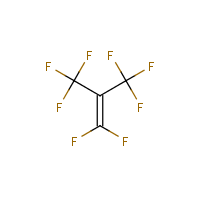Perfluoroisobutylene
Agent Name
Perfluoroisobutylene
Alternative Name
PFIB
CAS Number
382-21-8
Formula
C4-F8
Major Category
Other Uses

Synonyms
PFIB; Isobutene, octafluoro-; Octafluoro-sec-butene; Octafluoroisobutylene; 1-Propene, 1,1,3,3,3-pentafluoro-2-(trifluoromethyl)-; [ChemIDplus] 1,1,3,3,3-Pentafluoro-2-trifluoromethyl-1-propene; [ICSC] Octafluoroisobutene; [HSDB]
Category
Pyrolysis Products
Description
Colorless gas; [ICSC] Colorless gas that is a colorless liquid when stored under its own pressure; [SynQuest Laboratories MSDS]
Sources/Uses
A decomposition product of Teflon (R) when heated to about 425 degrees C; [ICSC] Used for etching in semiconductor fabrication and to make polymeric materials; [HSDB]
Comments
Heating polytetrafluoroethylene (PTFE) to approximated 425 degrees C releases this toxic gas as a thermal degradation product. The 3 minute LC50 value for rats, rabbits, and mice ranges from 61 to 183 ppm. Poisoned animals have pulmonary and renal hemorrhages. Surviving animals recovered fully and showed no long-term ill effects. [ACGIH] Teflon is the brand name for PTFE. Inhalation of perfluoroisobutylene in high concentrations can cause pneumonitis, pulmonary edema, and death. [ICSC] PFIB is one of the pulmonary agents that could be used as chemical weapons. It is 10 times more toxic than phosgene. [Weinstein, p. 134] Cough, chest pain, dyspnea, fever, and delayed pneumonitis and pulmonary edema have been reported in humans following acute inhalation exposure; [HSDB] Many military vehicles are lined with Teflon (R) and may release PFIB in a fire; [DOD] Extremely toxic by inhalation (pulmonary edema); Evaporating liquid may cause frostbite; [SynQuest Laboratories MSDS] See "Polymer fume fever" in Diseases.
Biomedical References
Exposure Assessment
Skin Designation (ACGIH)
Insufficient data
TIH
Yes
Ceiling (ACGIH)
0.01 ppm
Lethal Concentration
LC50 (rat) = 0.5 ppm/6hr
Explanatory Notes
LC50 (rat) = 17 ppm/10min; 1.05 ppm/2hr; [HSDB]
ERPG-1
Not appropriate
ERPG-2
0.1 ppm
ERPG-3
0.3 ppm
Adverse Effects
Toxic Pneumonitis
Yes
Diseases, Processes, and Activities Linked to This Agent
Diseases
Occupational diseases associated with exposure to this agent:
Processes
Industrial Processes with risk of exposure: